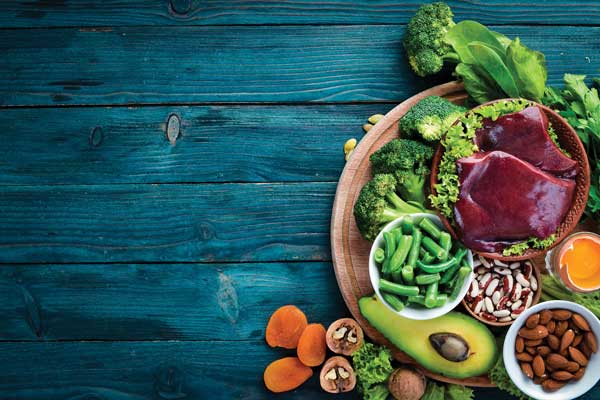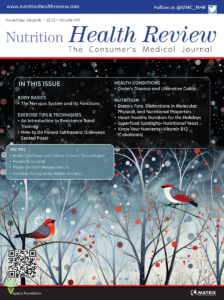
Iron is an essential mineral found in of hemoglobin, a protein that is responsible for transferring oxygen from the lungs throughout the body, and myoglobin, a protein that stores oxygen in muscle tissues. Additionally, iron is necessary for proper growth, brain development, cellular functioning, and hormone synthesis.1–3
Dietary iron comes in two forms: heme and nonheme. Heme iron is only present in animal-derived foods (e.g., meat, poultry, fish), whereas nonheme iron is found in both animal- and plant-derived foods, as well as iron-fortified foods.1–3
The body absorbs about 25 percent of dietary heme iron and 17 percent of dietary nonheme iron,2 and heme iron contributes to 10 to 15 percent of dietary iron intake in the typical Western diet; as such, vegetarians and vegans need to consume almost twice as much iron than people who eat meat.1,2
Iron absorption can be inhibited or aided by the presence of certain substances. Phytates, present in legumes and unrefined grains; polyphenols, present in black or pekoe tea, red wine, coffee, and oregano; and calcium inhibit iron absorption. Ascorbic acid (vitamin C) enhances iron uptake and inhibits iron absorption inhibitors. Additionally, eating meat, fish, or poultry with vegetables increase nonheme iron absorption 2- to 3-fold.2,4,5
The average adult has an iron content of about 3g, with about 1g lost each day due to the shedding of cells from skin and mucosal surfaces, most notably from the gastrointestinal tract. Menstruation increases daily iron loss, so premenopausal individuals require a higher iron intake.2,4
Those most at-risk for an iron deficiency are infants and children, menstruating or pregnant individuals, frequent blood donors, and those with inadequate access to iron in their diets.1–4
Iron deficiency occurs in three stages. First, iron stores decrease, but the body is not functionally affected. In the second stage, iron stores are depleted and red blood cell production decreases. If left untreated, iron-deficiency anemia (IDA) develops, in which iron stores are completely depleted, hemoglobin levels decrease, and there is a significant loss of total red blood cells.1–3 Symptoms of IDA include fatigue, weakness, pale skin, cold hands and feet, impaired immune function, gastrointestinal disturbances, and impaired cognitive function.1–3,6 IDA can be treated with oral iron supplements in many cases, although intravenous (IV) iron might be required for individuals with severe IDA or long-term conditions.6
Iron toxicity is rare, but it can occur with excessive consumption of iron supplements. Symptoms include gastrointestinal disturbances, including nausea, vomiting, constipation, and diarrhea.1–3
Recommended Intake and Sources
The recommend daily allowance (RDA) for adolescents aged 9 to 13 years is 8mg. For male/nonmenstruating individuals, the RDA is 11mg from the ages of 14 to 18 years and 8mg for 19+ years. For female/menstruating individuals, the RDA is 15mg from the ages of 14 to 18 years, 18mg for 19 to 50 years, and 8mg for 51+ years.1 However, individuals who are premenopausal past the age of 50 years should still adhere to the RDA for those under the age of 51 years.3 The RDA for pregnant and lactating individuals is 27mg and 9mg, respectively.1
Good sources of heme iron include:
- Oysters: 6.9mg per 3 oysters
- Mussels: 5.7mg per 3oz
- Duck breast: 3.8mg per 3oz
- Turkey eggs: 3.2mg per egg
- Beef: 2.5mg per 3oz
- Canned sardines: 2.5mg per 3oz
- Clams: 2.4mg per 3oz
- Shrimp: 1.8mg per 3oz7
Good sources of nonheme iron include:
- Fortified cereals: 8.4 to 16.2mg per serving (varies depending on type of cereal, e.g. whole grain kernels, bran flakes)
- Spinach, cooked: 6.4mg per cup
- Soybeans, cooked: 4.4mg per ½ cup
- Lima beans, cooked: 4.2mg per cup
- Swiss chard, cooked: 4mg per cup
- Lentils, cooked: 3.3mg per ½ cup
- Prune juice: 3.0mg per cup
- Mushrooms: 2.7mg per cup7
Multivitamin/multimineral supplements with iron, especially those created for women, typically contain 18mg of iron. Iron-only supplements are also available, typically containing 65mg of iron, but these supplements can cause gastrointestinal side effects.1,2 Consult your physician before taking an iron-only supplement.
Sources
- National Institutes of Health Office of Dietary Supplements. Iron: fact sheet for health professionals. Updated 5 Apr 2022. https://ods.od.nih.gov/factsheets/Iron-HealthProfessional/. Accessed 20 Dec 2022.
- Moustarah F, Daley SF. Dietary Iron. Updated 22 Oct 2022. In: StatPearls [Internet]. StatPearls Publishing; 2022.
- Harvard T.H. Chan School of Public Health. Iron. https://www.hsph.harvard.edu/nutritionsource/iron/. Accessed 20 Dec 2022.
- Abbaspour N, Hurrell R, Kelishadi R. Review on iron and its importance for human health. J Res Med Sci. 2014;19(2):164–174.
- MedlinePlus. Iron in diet. Reviewed 11 Mar 2021. https://medlineplus.gov/ency/article/002422.htm. Accessed 20 Dec 2022.
- National Heart, Lung, and Blood Institute. Iron-deficiency anemia. Updated 24 Mar 2022. https://www.nhlbi.nih.gov/health/anemia/iron-deficiency-anemia. Accessed 20 Dec 2022.
- Dietary Guidelines for Americans. Food sources of iron. https://www.dietaryguidelines.gov/resources/2020-2025-dietary-guidelines-online-materials/food-sources-select-nutrients/food-1. Accessed 20 Dec 2022.





